Leh, Ladakh and environs
I've been talking about leaving Ladakh for a few weeks...yet keep finding reasons to stay. Here is another one.
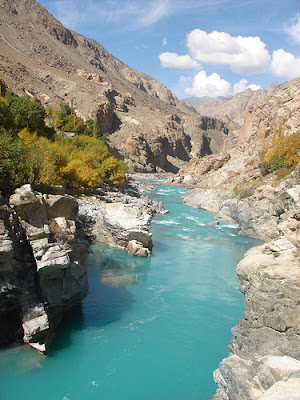
Ladakh is a great place to breathe.
In most of India (ironically the home of yogic deep breathing or pranayama), you really don't want to breathe too deeply. Either the air is horribly polluted, or there are dreadful smells nearby if you breathe more than superficially. After a while, you forget that you are not breathing properly.
I knew a guy in New York that said incense was bad for meditation, because you breathe in too much smoke that way. Obviously, he had never been to India. Compared to what you normally breathe here, incense smoke is benign, and pleasant.
Once you adjust to altitude and catch your breath, Ladakh has plenty of deep breathing space. Here is an exercise that is great for Ladakh:
"Now and again, it is necessary to seclude yourself among deep mountains and hidden valleys to restore your link to the source of life.
"Breathe in and let yourself soar to the ends of the universe; breathe out and let the cosmos back inside.
"Next, breathe up all the fecundity and vibrancy of the earth.
"Finally, blend the breath of heaven and the breath of the earth with that of your own, becoming the breathe of life itself."
- Morihei Ueshiba Osensei
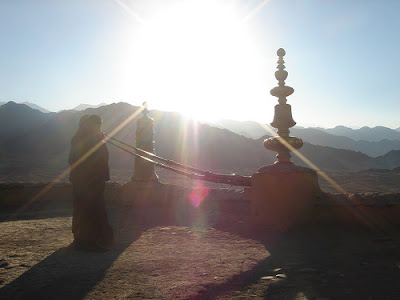 Last week, in honour of both my birthday and Halloween, I spent 6 days in various remote monasteries in Leh valley area. I attended the Thiksey GuStor masked dancing ritual and festival, and visited Shey Gompa (which includes a ruined palace, the former home of the Ladakhi kings), Stakna Gompa (a Drukpa Kagyu monastery, patronized by the kings of Bhutan) and the out-of-the-way Matho Gompa, famous for its tradition of Oracles, or monks who become "possesed" by a protector deity and answer questions about the future.
Last week, in honour of both my birthday and Halloween, I spent 6 days in various remote monasteries in Leh valley area. I attended the Thiksey GuStor masked dancing ritual and festival, and visited Shey Gompa (which includes a ruined palace, the former home of the Ladakhi kings), Stakna Gompa (a Drukpa Kagyu monastery, patronized by the kings of Bhutan) and the out-of-the-way Matho Gompa, famous for its tradition of Oracles, or monks who become "possesed" by a protector deity and answer questions about the future. Here are a few random photos.
You know that Incredible India tourism ad that shows the monks blowing horns at dawn? It was made at Thiksey Monastery. This is how it looks in real life. I think they only wear the yellow hats if you are from India Tourism!
Here (below) are two of the dozens of masked dancers at Thiksey Gustor. At the end of the ritual, the Torma, or gruesomely-shaped barley cakes that represent sacrifices to negative forces (they used to be real animal sacrifices, back in the bad old days) are brought outside, thrown over a cliff and burned, amid much fanfare and dancing.
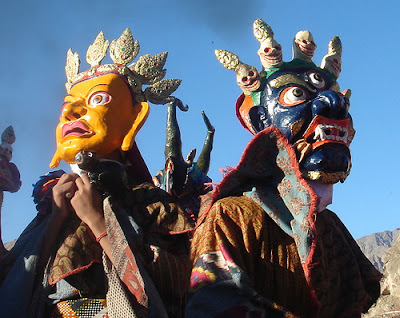 This old timer gladly posed for me at Thiksey, whirling his prayer wheel. And, he did not ask for money! (below). I am quite fond of this traditional Ladakhi hat. It serves absolutely no practical purpose (doesn't keep your head warm, or keep the sun or wind off) - it's just a goofy kind of top hat with horns. Very jaunty.
This old timer gladly posed for me at Thiksey, whirling his prayer wheel. And, he did not ask for money! (below). I am quite fond of this traditional Ladakhi hat. It serves absolutely no practical purpose (doesn't keep your head warm, or keep the sun or wind off) - it's just a goofy kind of top hat with horns. Very jaunty. Thiksey Gompa is very easily reached by a half-hour or so's bus ride (15 Rs, or about 45 cents) from the New Bus Stand. Buses leave all day long and the last one back to Leh is at about 5 or 6pm (no one knows for sure). In season, Thiksey has a fantastic guest house, well furnished with beautiful views (a bit pricey at 300Rs or $8.00 for single occupancy), and a good restaurant (run by Nepali staff) that has a killer veg thali for 45Rs. I was there the very last day of the guest house season....when they shut the water off and the Nepalis went south. Quite sad, really. There is also a family-run guest house in the village but then you must climb up the steep hillside to the gompa every day. (However, it is much cheaper than 300Rs.)
Thiksey Gompa is very easily reached by a half-hour or so's bus ride (15 Rs, or about 45 cents) from the New Bus Stand. Buses leave all day long and the last one back to Leh is at about 5 or 6pm (no one knows for sure). In season, Thiksey has a fantastic guest house, well furnished with beautiful views (a bit pricey at 300Rs or $8.00 for single occupancy), and a good restaurant (run by Nepali staff) that has a killer veg thali for 45Rs. I was there the very last day of the guest house season....when they shut the water off and the Nepalis went south. Quite sad, really. There is also a family-run guest house in the village but then you must climb up the steep hillside to the gompa every day. (However, it is much cheaper than 300Rs.) During GuStor, Thiksey, like most monasteries during their annual festival, becomes the epicentre of social life in the area. Locals descend en masse, as much to pay respects to the gods and lamas as to socialize. (This is especially evident in the behaviour of the younger people.) Vendors set up stalls and tents in the village below the monastery, selling plastic wares, mo-mos, simple food and tea, and playing Hindi film music. This gives a carnival atmosphere and I noticed several younger people getting intoxicated (outside the monastery, of course).
Below is one of the dancers after the torma-burning. Peek a boo!
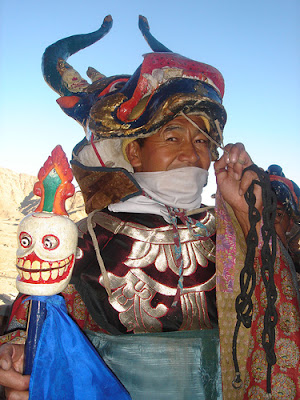










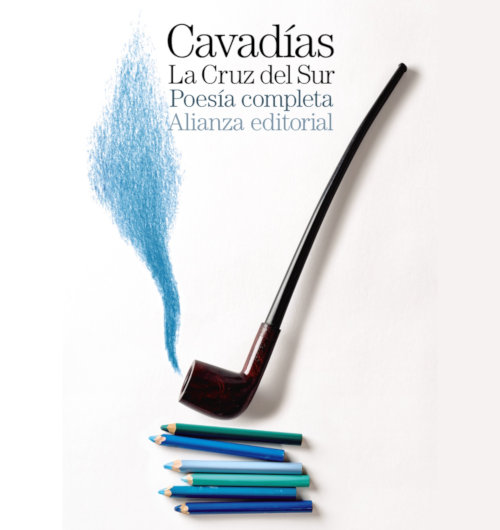



No comments:
Post a Comment